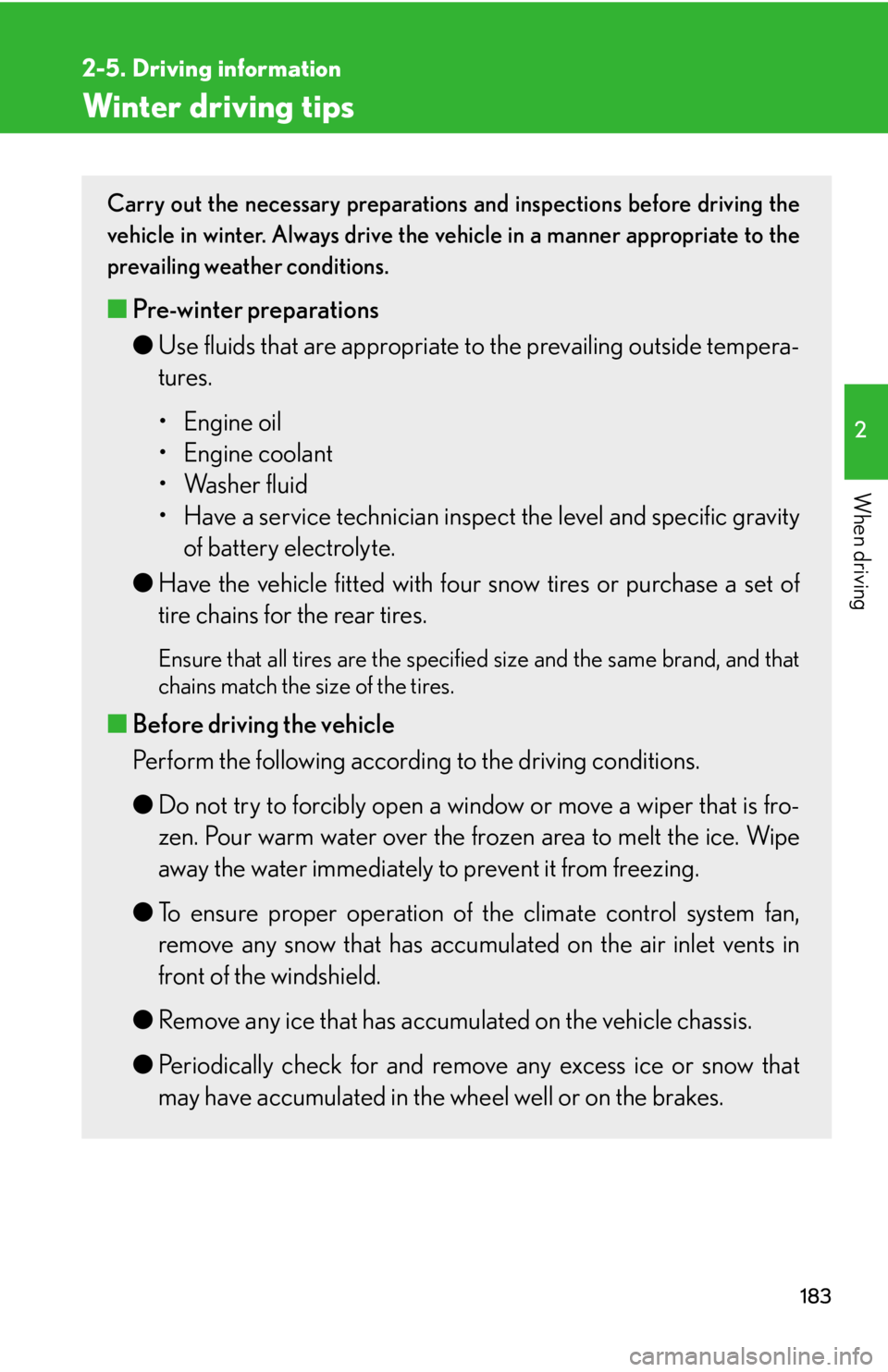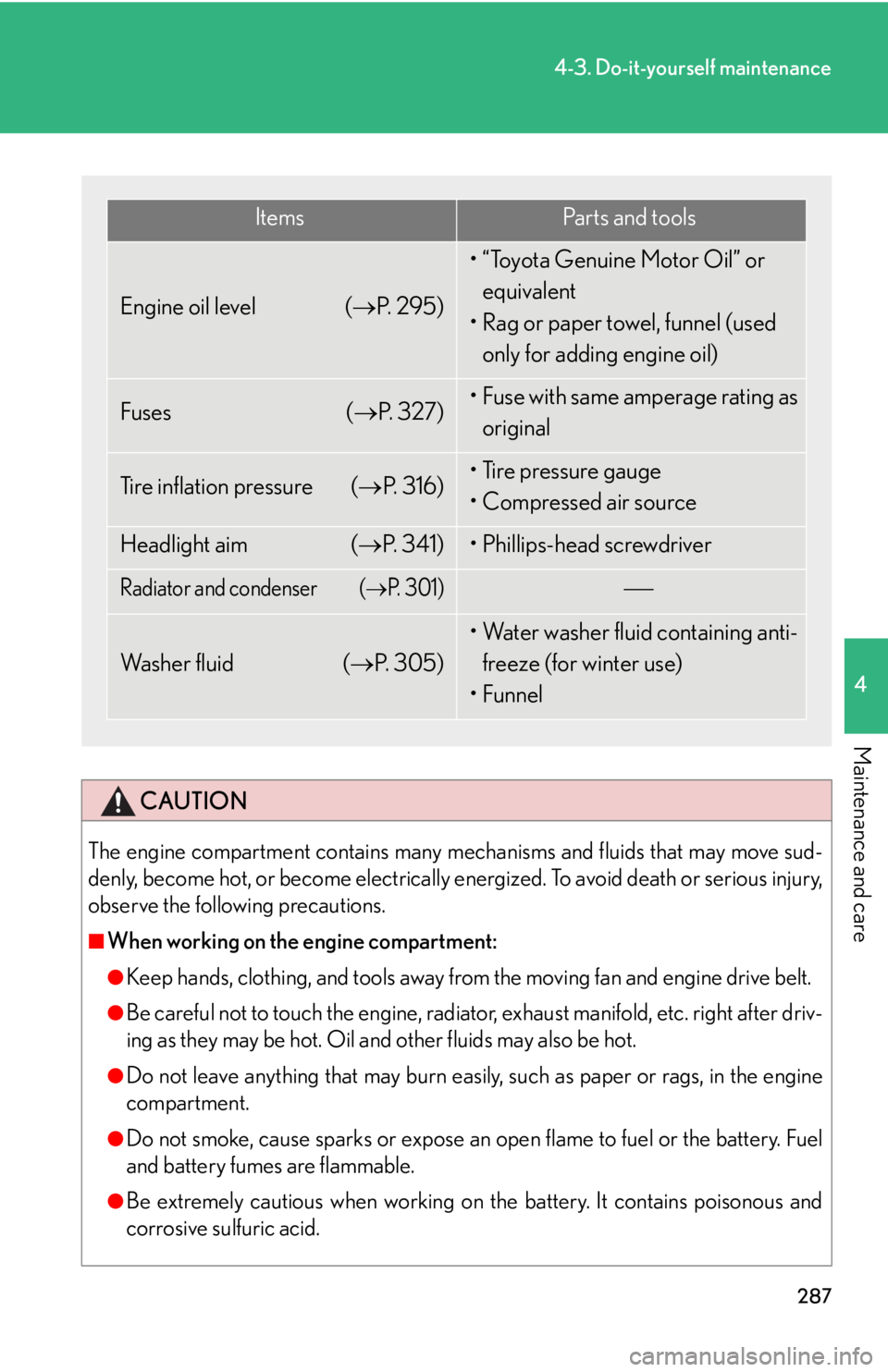washer fluid Lexus IS250 2008 Using the air conditioning system and defogger / LEXUS 2008 IS250 OWNER'S MANUAL (OM53699U)
[x] Cancel search | Manufacturer: LEXUS, Model Year: 2008, Model line: IS250, Model: Lexus IS250 2008Pages: 464, PDF Size: 6.61 MB
Page 149 of 464

149
2-3. Operating the lights and windshield wipers
2
When driving
■Rain drop sensor (vehicles equipped with the rain-sensing windshield wipers)
■Outside rear view mirror defogger activa tion linked to windshield wiper opera-
tion
The outside rear view mirror defogger au tomatically turns on when you operate the
windshield wipers.
■If no windshield washer fluid sprays
Check that the washer nozzles are not blocked if there is washer fluid in the wind-
shield washer fluid reservoir.
■Customization that can be configured at Lexus dealer
Settings (e.g. drip prevention function) can be changed. (Customizable features
P. 4 3 6 )
CAUTION
■Caution regarding the use of windshield wipers in “AUTO” mode
The windshield wipers may operate unexpectedly if the sensor is touched or the
windshield is subject to vibration in “AUT O” mode. Take care that your fingers or
anything else do not become caught in the windshield wipers.
The sensor judges the amount of raindrops.
Page 150 of 464

150
2-3. Operating the lights and windshield wipers
NOTICE
■When the windshield is dry
Do not use the wipers, as they may damage the windshield.
■When there is no washer fluid spray from the nozzle
Damage to the washer fluid pump may be caused if the lever is pulled toward you
and held continually.
■When using an automatic car wash
Set the wiper switch to “OFF”.
If the wiper switch is in “AUTO”, the wipers may operate and the wiper blades may
be damaged.
Page 151 of 464

151
2-3. Operating the lights and windshield wipers
2
When driving
Headlight cleaner switch (if equipped)
■The headlight cleaner can be operated when
When the “ENGINE START STOP” switch is in IGNITION ON mode and the
headlight switch is turned on.
NOTICE
■When the washer fluid tank is empty
Do not use this function when the washer fluid tank is empty. This may cause the
washer fluid pump to overheat.
Washer fluid can be sprayed on the headlights.
Press the switch to clean the
headlights.
Page 183 of 464

183
2-5. Driving information
2
When driving
Winter driving tips
Carry out the necessary preparations and inspections before driving the
vehicle in winter. Always drive the vehicle in a manner appropriate to the
prevailing weather conditions.
■ Pre-winter preparations
●Use fluids that are appropria te to the prevailing outside tempera-
tures.
• Engine oil
• Engine coolant
• Washer fluid
• Have a service technician inspect the level and specific gravity
of battery electrolyte.
● Have the vehicle fitted with four snow tires or purchase a set of
tire chains for the rear tires.
Ensure that all tires are the specified size and the same brand, and that
chains match the size of the tires.
■ Before driving the vehicle
Perform the following according to the driving conditions.
● Do not try to forcibly open a w indow or move a wiper that is fro-
zen. Pour warm water over the frozen area to melt the ice. Wipe
away the water immediately to prevent it from freezing.
● To ensure proper operation of the climate control system fan,
remove any snow that has accumu lated on the air inlet vents in
front of the windshield.
● Remove any ice that has accumul ated on the vehicle chassis.
● Periodically check for and remove any excess ice or snow that
may have accumulated in the wheel well or on the brakes.
Page 287 of 464

287
4-3. Do-it-yourself maintenance
4
Maintenance and care
CAUTION
The engine compartment contains many mechanisms and fluids that may move sud-
denly, become hot, or become electrically energized. To avoid death or serious injury,
observe the following precautions.
■When working on the engine compartment:
●Keep hands, clothing, and tools away from the moving fan and engine drive belt.
●Be careful not to touch the engine, radiator , exhaust manifold, etc. right after driv-
ing as they may be hot. Oil and other fluids may also be hot.
●Do not leave anything that may burn easi ly, such as paper or rags, in the engine
compartment.
●Do not smoke, cause sparks or expose an open flame to fuel or the battery. Fuel
and battery fumes are flammable.
●Be extremely cautious when working on the battery. It contains poisonous and
corrosive sulfuric acid.
ItemsPa r t s a n d t o o l s
Engine oil level ( P. 2 9 5 )
• “Toyota Genuine Motor Oil” or
equivalent
• Rag or paper towel, funnel (used only for adding engine oil)
Fuses ( P. 3 2 7 )• Fuse with same amperage rating as
original
Tire inflation pressure ( P. 3 1 6 )• Tire pressure gauge
• Compressed air source
Headlight aim ( P. 3 4 1 )• Phillips-head screwdriver
Radiator and condenser (P. 3 0 1 )
Wa s h e r f l u i d (P. 3 0 5 )
• Water washer fluid containing anti-
freeze (for winter use)
•Funnel
Page 292 of 464

292
4-3. Do-it-yourself maintenance
Engine compartment
IS350
Battery (P. 302)
Engine oil level dipstick (P. 295)
Engine oil filler cap (P. 295)
Brake fluid reservoir (P. 301)
Fuse boxes ( P. 327)Washer fluid tank
(P. 305)
Electric cooling fans
Condenser ( P. 301)
Radiator ( P. 301)
Engine coolant reservoir (P. 2 9 9 )
Page 293 of 464

293
4-3. Do-it-yourself maintenance
4
Maintenance and care
IS250
Battery (P. 302)
Engine oil level dipstick (P. 295)
Engine oil filler cap (P. 295)
Brake fluid reservoir (P. 301)
Fuse boxes ( P. 327)Washer fluid tank
(P. 305)
Electric cooling fans
Condenser ( P. 301)
Radiator ( P. 301)
Engine coolant reservoir (P. 2 9 9 )
Page 305 of 464

305
4-3. Do-it-yourself maintenance
4
Maintenance and care
Washer fluidIf any washer does not work or the
warning message appears on the
multi-information display, the
washer tank may be empty. Add
washer fluid.
NOTICE
■When recharging the battery
Never recharge the battery while the engine is running. Also, be sure all accesso-
ries are turned off.
CAUTION
■When refilling the washer fluid
Do not refill the washer fluid when the engine is hot or running, as the washer fluid
contains alcohol and may catch fire if spilled on the engine etc.
NOTICE
■Do not use any fluid other than washer fluid
Do not use soapy water or engine antifreeze instead of washer fluid.
Doing so may cause streaking on the vehicle’s painted surfaces.
■Diluting washer fluid
Dilute washer fluid with water as necessary.
Refer to the freezing temperatures listed on the washer fluid tank.
Page 347 of 464

347
4-3. Do-it-yourself maintenance
4
Maintenance and care
■When replacing the front left headlight and parking light bulbs
■Condensation build-up on the inside of the lens
Contact your Lexus dealer for more inform ation in the following situations. Tempo-
rary condensation build-up on the inside of the headlight lens does not indicate a
malfunction.
●Large drops of water are built up on the inside of the lens.
●Water has built up in side the headlight.
■Discharge headlights (if equipped)
If voltage to the discharge bulbs is insufficient, the bulbs may not come on, or may
go out temporarily. The discharge bulbs will come on when normal power is
restored.
Remove the securing bolt and move the
washer fluid filler opening to allow easy
access to the light bulbs.
After replacing the bulbs, make sure to
secure the washer fluid filler opening with the
bolt.
Page 374 of 464

374
5-2. Steps to take in an emergency
Wa r n i n g m e s s a g eDetailsCorrection procedure
Indicates that the trunk is
not fully closed. flashes and a
buzzer sounds to indi-
cate that trunk is not fully
closed (with the vehicle
having reached a speed
of 3 mph [5 km/h]).
Close the trunk.
(Flashing)
Indicates that the moon
roof is not fully closed
(with the “ENGINE
START STOP” switch
OFF and the driver’s
door opened).
Close the moon roof.
Indicates that the parking
brake is still engaged.
flashes and a
buzzer sounds to indi-
cate that the parking
brake is still engaged
(with the vehicle having
reached a speed of 3
mph [5 km/h]).
Release the parking
brake.
Indicates that the washer
fluid level is low.Add washer fluid.